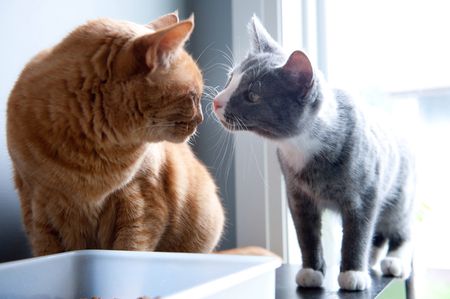Feline interactions are too twisted to be predicted. Comprehending a cat’s response to introducing a new subject in its environment is fairly easy, but you cannot tell for sure if the response is a constant one. Indeed, cats are famous for arrogance and a little selfishness in favor of their masters. Hence, they might not react kindly to introducing a new member in the house, even if it is of the same species. But there are several clever tricks and techniques you can follow so that the interaction with the new cat is a peaceful and harmonious one. In this discussion, we will talk about such clever ways in which you can introduce two cats to each other, without any catfights!
It starts before you take a new cat home.

There are certain things that you need to do before you bring the new fellow home. If you decide to spring up a surprise on your resident cat, you can expect the following reaction to being not a very kind one. How would you like it if you were to learn that you will have to share your things with a total stranger? Cats have feelings, respect them. So, after that rather sentimental note, let us have a look at the steps you need to take before you introduce the resident and the newcomer cat. Well, the first thing to consider is, of course, the accommodation. Where is the new boy or girl going to live? There is always a territory in the house where a cat feels most comfortable. We doubt the resident cat will feel like sharing the room with the newcomer, so you will have to set up the base camp elsewhere. Two important considerations in this regard must be kept in mind. One is about the scent; cats are all about the scent of their masters, so make sure that the newcomer’s cathouse has soaked enough of your scent. Second, please don’t keep your cats’ poles apart. They are pets, not monsters!
No first impressions
For some reason, you decided to bring a new cat home. You must be patient and not well up if you see your pets in the paw-to-paw fight. But we doubt it will come to that if you follow some of the tips you are about to tell you. Well, the ideal thing to do is to familiarize the newcomer with the scent of your resident cat. How are you going to do it, though? Well, why don’t you move the resident cat to another room for some time? That way, you can allow the newcomer to roam about the place without the risk of being attacked by a sulky resident cat. The first place that the newcomer should visit is the abode of the resident cat. You achieve two goals by doing that. One, the new boy or girl gets a homey feel about the new place. Second, the scent of your resident cat and not the cat itself might lead to the beginning of a peaceful relationship between the two animals. It is critical that while all of this happens, the two cats must not lay eyes on each other.
No cat’s land

Like the phrase? Wait till you have to devise one. This is a step that is necessary to the goal of cat cordiality that you are so desperately seeking. So, how do you achieve this? There are two ways in which you can divide the feline residencia in your home. The first method of creating a division is to use a curtain cleverly. It has proven to be an effective method of creating a space between the abodes of two cats. However, in terms of penetration and invasion, it is not a great idea. If the pets are nothing but quarrelsome, you will find them rolling soon despite the separation. A piece of clothing cannot impede the catty anger for too long! The other method is to install a door that bifurcates a cat’s dwelling into two. In our opinion, this is a much better idea, especially when the cats are total strangers. It is also effective in terms of control since both pets are at your mercy. This is a training behavior that will knock some sense into the furballs for sure. If this idea appeals to you, you can look for a pet door or order a custom one.
A room full of love

The moment for which we all have been waiting is finally here! It is meet-up time; the first interaction between the resident and the newcomer is about to happen. How should this happen and where should it happen are two important questions that will determine this interaction. A room other than the cat hostel should be used for this purpose. First, chuck in all the favorite stuff that your resident cat feels happy about and do the same for the newcomer as well. This includes the stuff that your cats love to gobble up as well. The key theme of this interaction is that your cats must have an activity of some sort to do when they are free. If the pets aren’t eating from the same bowl, they should be playing with the same ball, at least. It is too much to expect that your cats will be in a harmonious relationship from the moment they set their eyes on each other. However, you can expect things to improve if you follow this approach. Oh, and you will have to time these sessions. This is something that we talk about in detail in the next section of this discussion.
Take it slow
These sessions need to be ended early in the beginning. You can increase the timing as things get better. We understand your desperation to get your cats all friendly and homey. But you need to understand that everyone has a different approach to life. Yes, it applies to cats as well! You might do everything in your capacity to make this introductory phase as friendly as possible, and yet, the results might not be entirely what you were after. If there comes the point where your cats are pulling each other’s fur out while you are tearing your hair out in frustration as well, you need to be patient. Yes, taking it slow is the key agenda here. You cannot expect cordiality to develop overnight or in just a week. Let your cats mingle as much as they can. Also, keeping an eye over your pets all the time isn’t a great idea either. Give them some time in which you aren’t looking over them. You never know, things might improve magically in those moments when you aren’t over there! The upshot of all this is that you need to stick by the decision you made.
Be creative

Little acts of pure genius are needed to make this thing work. You will need to summon up all the creativity and imagination that you possess. Put those grey cells at work! We don’t mean to corrupt your creative thought process, so we will refrain from going into the details. However, there are certain things that you can try and see if they work for your cats:
1- How you let cats enter the comfortable room also matters a lot. You cannot be rude enough to introduce two royalties into the happy palace at the same time. No, sir, you will have to follow a certain protocol here. What you can do is let the resident cat enter first because of well seniority matters. Then, you can bring the other cat into the room but don’t lead the new pet straight to the resident cat. The ideal thing to do would be to let the cats get into a happy mood first. Oh, that’s easy to achieve. Just chuck in their favorite food or toys!
2- Let the rhythm get your cats! Follow this schedule for at least two weeks despite any signs of reluctance or pleasure on your cat’s part. This behavioral training can certainly put a lot of weight into your cause, and your goals might be achieved sooner rather than later.
Conclusion
We wish we could go on a bit more. This is such a fascinating but extensive topic that cannot be covered in one space. The feline world is different from humans; its norms and values are of extreme importance to the furballs and tomcats. Observation has helped humans to deduce theories, which, once put into practice, yielded satisfactory results. What you read in this article is all a product of observation. So we daresay, if you observe the interaction between your resident cat and the newcomer cat closely, you will notice a few subtle points that you can use to your advantage. But we daresay the senior cat will always be closer to your heart! Well, on that sweet note, we bid you farewell from this discussion!